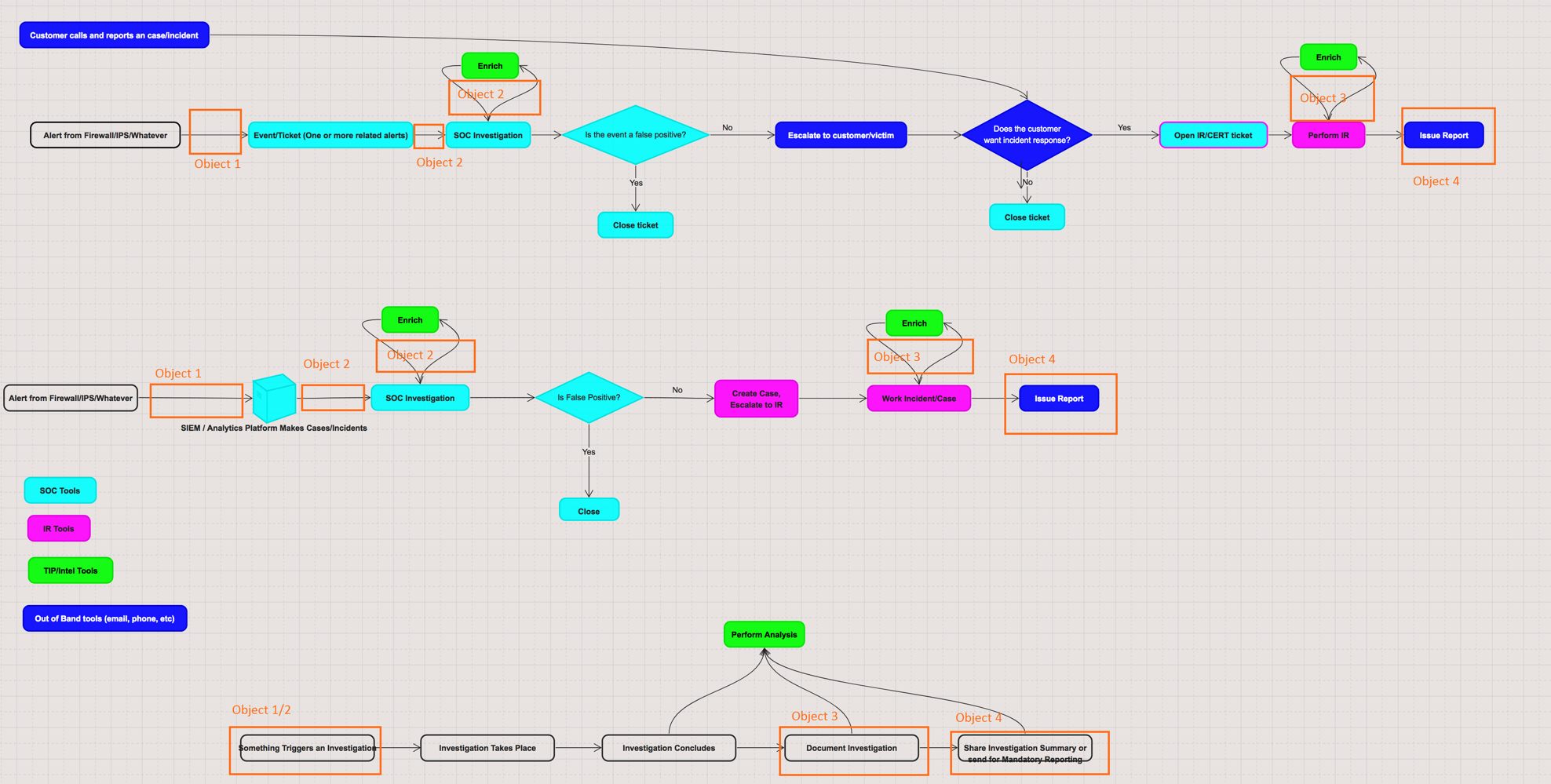Hi Sarah,
Below is my take on the different objects.
Object 2&3 can be combined but it might be better to leave them separate since the consumers that work with them are different
today.
|
Objects |
Purpose |
Producer |
Consumer |
CTI Requirements |
|
Object1 |
Captures data from sensors and is sent to a data analytics platform for further processing |
Sensor -
|
Data analytics platform that does further processing on the data |
|
|
Object2 |
|
|
SOC tools /analysts
|
IP->Domain->URL,
IP, file hash->malware, campaign, threat actor etc.
|
|
Object3 |
|
|
|
|
|
Object4 |
Subset of Object2 and 3 with relevant details |
|
|
Report or Bundle? |
Thanks,
Jyoti Verma
Technical Leader,
CTO office Security Business Group,
Cisco Systems Inc.
From: <cti-stix@lists.oasis-open.org> on behalf of Sarah Kelley <Sarah.Kelley@cisecurity.org>
Date: Monday, September 11, 2017 at 6:40 AM
To: "cti-stix@lists.oasis-open.org" <cti-stix@lists.oasis-open.org>
Subject: [cti-stix] Current thoughts on Event Object
CTI-TC,
I have made an attempt to summarize the discussion to date surrounding the Event object. I have tried to use the diagrams that we’ve been referencing that show several workflows and where I see the various
SDOs we have been discussing.
I think there are five separate things that we’ve been talking about with regards to “Event”:
Object 1) Some sort of front end device sensing something. You could call this an alert, an event, a log line, etc.
Object 2) A somewhat more mature version of the thing above. It
may be one to one, but it may not be. There may be many of Object #1 that make up one Object #2.
Object 3) A way to document an incident/investigation that is either ongoing or concluded. This may (or may not) have come from an evolution out of an Object 1 or 2. Likely, most IR tools will not use Object
3 directly, so it should probably be a sort of summary object that can allow the results of an IR investigation to be linked back to all the related data (like Objects 1 and 2, but also Actors, malware, etc)
Object 4) Some sort of automated method of reporting, for cases such as mandatory reporting (like to US CERT).
Object 5) A way to group a bunch of related data together.
I see these as five distinct SDOs. Objects 1 and 2 are very similar, and
could be represented by one SDO, but if that was the case, then the SDO would need to have a relationship type of “this arglebargle is one of many arglebargles that make up this larger arglebargle”.
Object 1 has a lot of logistical overlap with a Sighting. There would need to be some sort of deconfliction between what properties were trying to be represented by Object 1 to make sure it wasn’t just a duplicate
of Sighting (which, by definition, is something that was ‘seen’, just as Object 1 was described to be). This could also just be an Observed Data object, if the it wasn’t actually “sighted”.
Object 2 is something that would likely be looked at by a SOC analyst. It isn’t really something that involves IR, but rather “is this thing my sensor generated good or bad?”
Object 3 is for your IR people or your CERT.
Object 4 is likely distinct from the Report object as we have it now, as it’s not likely to be in the same vein as a ‘published report’, but rather, “Here are the series of questions that US CERT makes me
answer every time we have an ‘incident’”.
Object 5 is basically what MISP has been asking for.
I believe Objects 1-3 roughly correlate to the first three objects from the FireEye proposal of “Event”, “Alert”, and “Investigation”. Object 5 is closer to their “Grouping” object.
All that being said, many of these tasks are not currently done in STIX (if not most of them). In the diagram, we have the TIP (in green) as being a separate object that lives alongside the workflow, but isn’t
really IN the workflow. That being said, if we added objects 1, 2, 4, and 5, I think it could allow for easier data flow into/out of a TIP. (I don’t think the IR object will ever be used directly by the types of tools that produce that data, but maybe
I’m wrong.)
Personally, I think the Event object as it currently stands is somewhat of a combination of Object 2 and Object 3. If people agree that these are really separate objects, I think we could scope out a few properties
and turn the current Event object into Object 2 or Object 3 fairly easily (or easily split it into two objects). I think Object 1 is out of scope for 2.1 (unless it’s already covered by sighting/Observed Data). I think Object 4 is out of scope for 2.1. I think
Object 5 will be covered by the “collection vs. report” debate/object, for which we should soon have a proposal.

Thoughts are appreciated.
Sarah Kelley
Senior Cyber Threat Analyst
Multi-State Information Sharing and Analysis Center (MS-ISAC)
31 Tech Valley Drive
East Greenbush, NY 12061
518-266-3493
24x7 Security Operations Center
SOC@cisecurity.org - 1-866-787-4722
This message and attachments may contain confidential information. If it appears that this message was sent to you by mistake, any retention, dissemination, distribution or copying of this message and attachments
is strictly prohibited. Please notify the sender immediately and permanently delete the message and any attachments.
. . . . .
.....
This message and attachments may contain confidential information. If it appears that this message was sent to you by mistake, any retention, dissemination, distribution or copying of this message
and attachments is strictly prohibited. Please notify the sender immediately and permanently delete the message and any attachments.
. . . . .